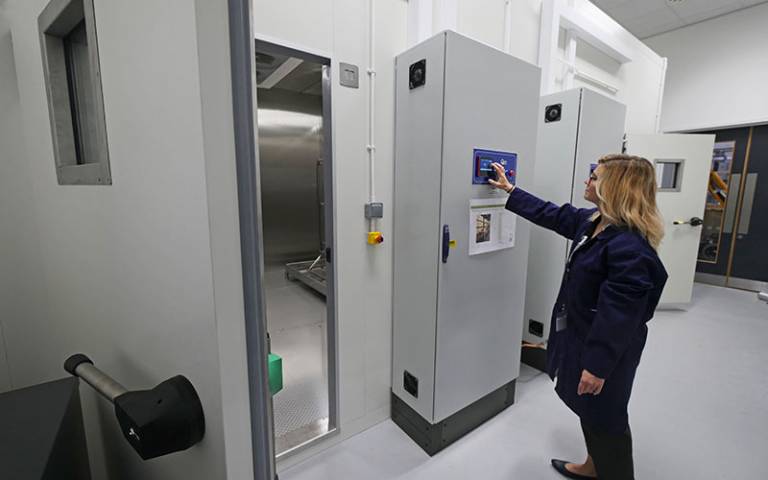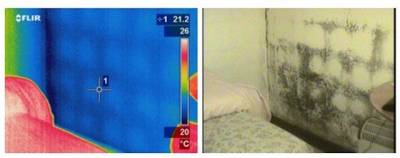UCL helps industry tackle the scourge of damp buildings
UCL architect and scientist Dr Hector Altamirano is helping industry and government better understand moisture in buildings and the considerable economic and health consequences it can have.

2 May 2019
The global impact of damp buildings
Across the world, dampness accounts for between 70% and 80% of all reported building problems – covering both structural complications and related health issues. In fact, there’s now a clearly established causality between moisture levels and asthma exacerbation – which, in the UK, could cost the NHS an estimated £200 million per year.
Dr Hector Altamirano, Senior Lecturer at the UCL Bartlett School of Energy, Environment and Resources, is an expert on the operational performance of buildings. With the help of researcher and technical manager Dr Valentina Marincioni, Hector oversees a lab that is uniquely designed to understand the effect of moisture in buildings.

Hector serves as the Academic Director of UCL’s UK Centre for Moisture in Buildings (UKCMB), which he co-founded to gather partners from academia, industry, and the public. Through this partnership, Hector realised that relatively little is known about excess moisture in buildings – and that existing knowledge isn’t adequately communicated with people working in relevant fields. So Hector and the UKCMB team sought a way to close this gap in understanding and bring academia and industry closer together.
Transforming knowledge and practice to industry
Through UCL Innovation & Enterprise, Hector secured knowledge exchange and innovation funding to develop a short course to share the latest academic knowledge about moisture in buildings.
He helped deliver two pilot courses for the UKCMB. In response to considerable initial interest in the courses, Hector was awarded a second round of knowledge exchange and innovation funding. This increased engagement with UKCMB members through six technical working groups, which are exploring the issues most important to those working in related fields. These issues include ventilation, retrofitting, new buildings, flooding, monitoring, modelling, policy and standards.
Innovation & Enterprise has also supported Hector’s work in the development of a two-year Knowledge Transfer Partnership (KTP) between the Property Care Association (PCA) and the UCL Institute for Environmental Design and Engineering (IEDE). This partnership and a grant from Innovate UK is enabling a comprehensive study into the problem of excess moisture in buildings, looking at both structural and health perspectives. The study’s findings will be used to develop a diagnostic tool and a strategy on tackling the issues.
Paula Lopez-Arce, KTP Research Associate for UCL and the PCA, said: “The KTP is hugely beneficial to academics at UCL, who are informed about the real needs of industry in order to develop practical research. In turn, industry is gaining scientific recognition and credibility through researchers’ findings.”
The UKCMB is currently supporting the UK government’s Department of Business, Energy and Industrial Strategy (BEIS) on a consultancy project supported by UCL Consultants, involving the study of moisture in cavity walls. This is managed by IEDE, UCL Civil Environmental and Geomatic Engineering (CEGE) and The Building Research Establishment (BRE) – led by Dr Hector Altamirano, Professor Dina D’Ayala and Colin King, respectively.
A digital platform for change
UKCMB’s continuing innovation in the field of moisture in buildings is already engaging a growing international audience of stakeholders. The short course is now being developed into an online course which will launch in summer 2019. There are plans to raise additional funding to translate the short course into other languages, so material can be shared in South America and Asia.
Dr Hector Altamirano concluded: “There’s a knowledge gap in terms of the problems relating to excess moisture in buildings, but we do know that issues can be significant in terms of building structure, health and economics. The help UCL Innovation & Enterprise has provided means we’re capable of having a far-reaching effect in the way moisture is understood and managed.”
The UKCMB’s core knowledge partners are the IEDE, CEGE and BRE.
Links
Find out more about:
- UCL Innovation & Enterprise’s funding schemes
- UK Centre for Moisture in Buildings (UKCMB)
- Property Care Association (PCA)
This project was supported by funding from the Higher Education Innovation Fund (HEIF)
Top photo is of the environmental laboratory at the UCL Institute for Environmental Design and Engineering (IEDE). Smaller photo shows thermal imaging of a damp wall - photo supplied by Dr Hector Altamirano.
 Close
Close

